Against the backdrop of rising international awareness of the importance of conserving and restoring natural capital, the likelihood of nature affecting business activities is increasing and companies are being called on to address this. Recognizing nature-related impact on business as a key management issue, the Joshin Group hereby discloses the results of analyses on our dependencies and impacts on nature, as well as the existing risks and opportunities, as our first disclosure based on the disclosure recommendations (ver. 1.0) of the Taskforce on Nature-related Financial Disclosures (TNFD).
- Application of materiality
The bidirectional impact between nature and business activities—nature’s impact on our business activities throughout our value chain and our business activities’ impact on nature—has been disclosed through the biodiversity relationship map in our Integrated Report 2024. Following this and considering how important the perspective of providing information to a broad range of stakeholders going forward is, we draw up our TNFD report using the double materiality approach.
- Scope of disclosures
This report covers the LEAP analysis we conducted, focusing on direct operations in our core business of the retail of products including home appliances, and discloses the results. Going forward, we will expand the scope of our analysis to include the upstream and downstream segments of our value chains and other areas.
- Location of nature-related issues
From among the total of 261 sites that are direct operation locations (stores, service centers, logistics centers, and offices), we selected 40 representative sites in consideration of their geographic locations and analyzed their interface with nature.
In addition, because stores, service centers, and logistics centers are sites believed to have comparatively greater dependence and impact on nature among our stores, service centers, logistics centers, and offices, we conducted dependence and impact analysis on operations at those three types of sites.
- Integration with other sustainability-related disclosures
Climate change and natural capital are mutually influential. The physical risks of direct operations are assessed using a scenario analysis of the risks of storms, flooding, and temperature rises under the 4℃-climate change scenario.
We are working to align our other sustainability issues as well and will actively disclose information through such means as our Integrated Reports and Securities Reports.
- Time horizons considered
As time horizons for its strategic and financial plans, the Group has defined the years up through 2025 as the short term, the years up through 2030 as the medium term, the years up through 2050 as the long term. These are consistent with the time horizons used to identify, assess, and manage not only our dependencies and impacts on biodiversity and climate change, but the related risks and opportunities as well.
- Engagement with Indigenous Peoples, local communities, and affected stakeholders in relation to the identification and assessment of our organization’s nature-related issues
To address the material issues that have a major impact on the Group’s corporate value creation and to successfully implement measures to resolve those issues, we participate in the United Nations Global Compact, an initiative to achieve sustainable growth of the global community. In addition to joining the UN Global Compact, we have formulated the Joshin Group Human Rights Policy in December 2022 with the aim of actively contributing to the establishment of a sustainable society through greater corporate value, achieved by exercising responsible leadership as a company listed on the Prime Market of the Tokyo Stock Exchange. The Policy states, “We will establish a human rights due diligence system, identify negative human rights impacts, and endeavor to deliver appropriate and effective remedies. We are also committed to building sustainable relationships with our stakeholders by responding with honesty and continuously engaging in dialogue with them.” In line with these stipulations, we identify human rights issues and assess their impact in collaboration with external expert organizations and through engagement with employees and others, taking the business activities and value chains that encompass the Group as the scope of consideration.
- Oversight function
The Board of Directors is the Group’s top decision-making body, and as such, it decides on important management matters including medium- to long-term management policies and business strategies aiming toward the creation of social and corporate value.
Among the members of the Board of Directors, the Group’s representative director, president and executive officer serves as the corporate representative, directing and overseeing business operations while also taking accountability on environmental issues.
The Group’s Board of Directors meets at least once a month for regular meetings, and it also flexibly holds extraordinary meetings as needed. In addition, the Board of Directors oversees efforts and progress made on policies, plans, targets, strategies, budgets, and other factors related to biodiversity and other environmental issues submitted to it by the Board of Executive Officers (chaired by the representative director, president and executive officer, this central organization for business execution consists of executive directors and executive officers; it is the top decision-making body on the execution of operations).
- Execution function
The Board of Executive Officers is consulted on the state of the Group’s action on nature-related plans and climate transition plans, as well as progress toward achievement of targets of the Science Based Targets Initiative (SBTi), by the Sustainability Committee (an organization that works to achieve the Group’s Management Philosophy and Management Vision by managing the seven material issues and 14 action items, together with the progress of key cross-divisional internal projects; it also comprehensively manages financial and nonfinancial information related to the Group’s business strategies, ESG initiatives, and other matters).
The Board of Executive Officers reports on these matters to the Board of Directors, which provides oversight and conducts monitoring. The Board of Executive Officers also formulates and submits business strategies that include measures to address nature-related and other environmental issues in general and annual budgets that include major capital expenditures to the Board of Directors, which then deliberates on these issues and provides instructions.
Furthermore, the Joshin Group Environmental Policy (including our commitment on biodiversity) drafted by the Climate Change Project, a section meeting under the Sustainability Committee, and deliberated on by the Sustainability Committee and the Board of Executive Officers was submitted to the Board of Directors, as was the assessment process for dependence, impact, risks, and opportunities that takes into account biodiversity. The Board of Directors oversees the contents of both the Policy and process and also monitors the progress achieved.
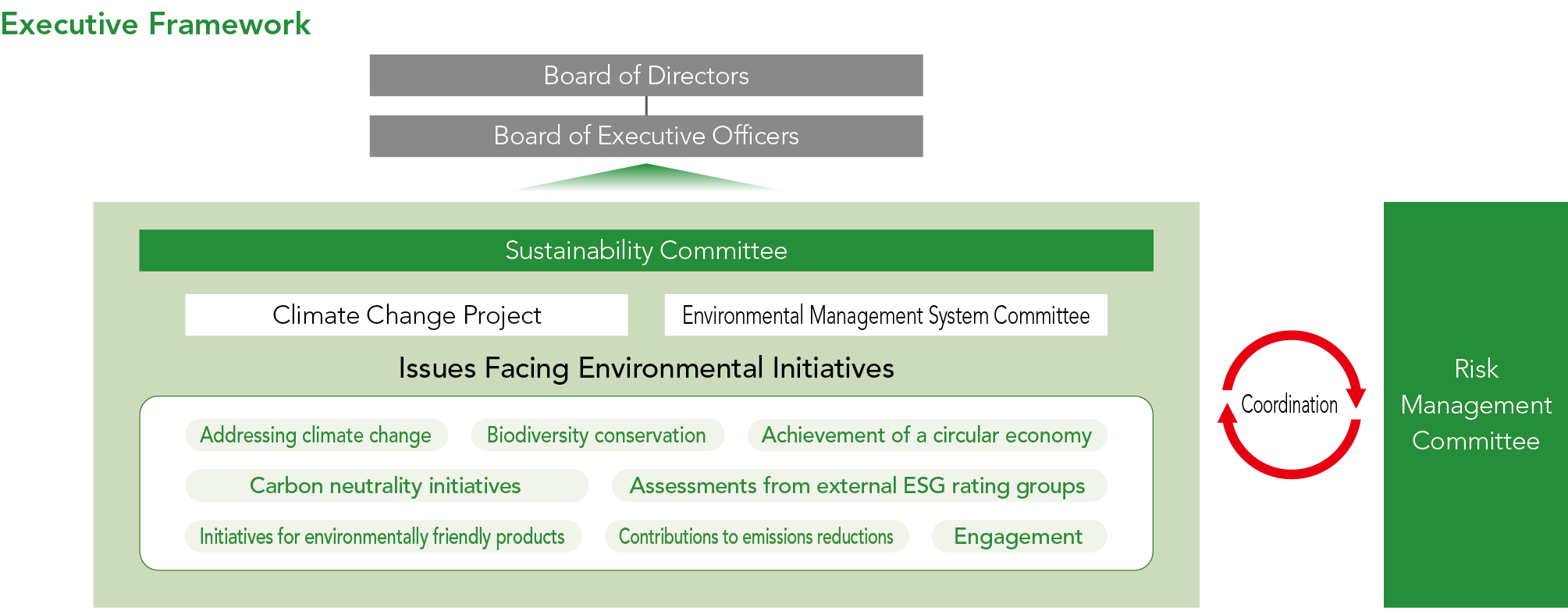
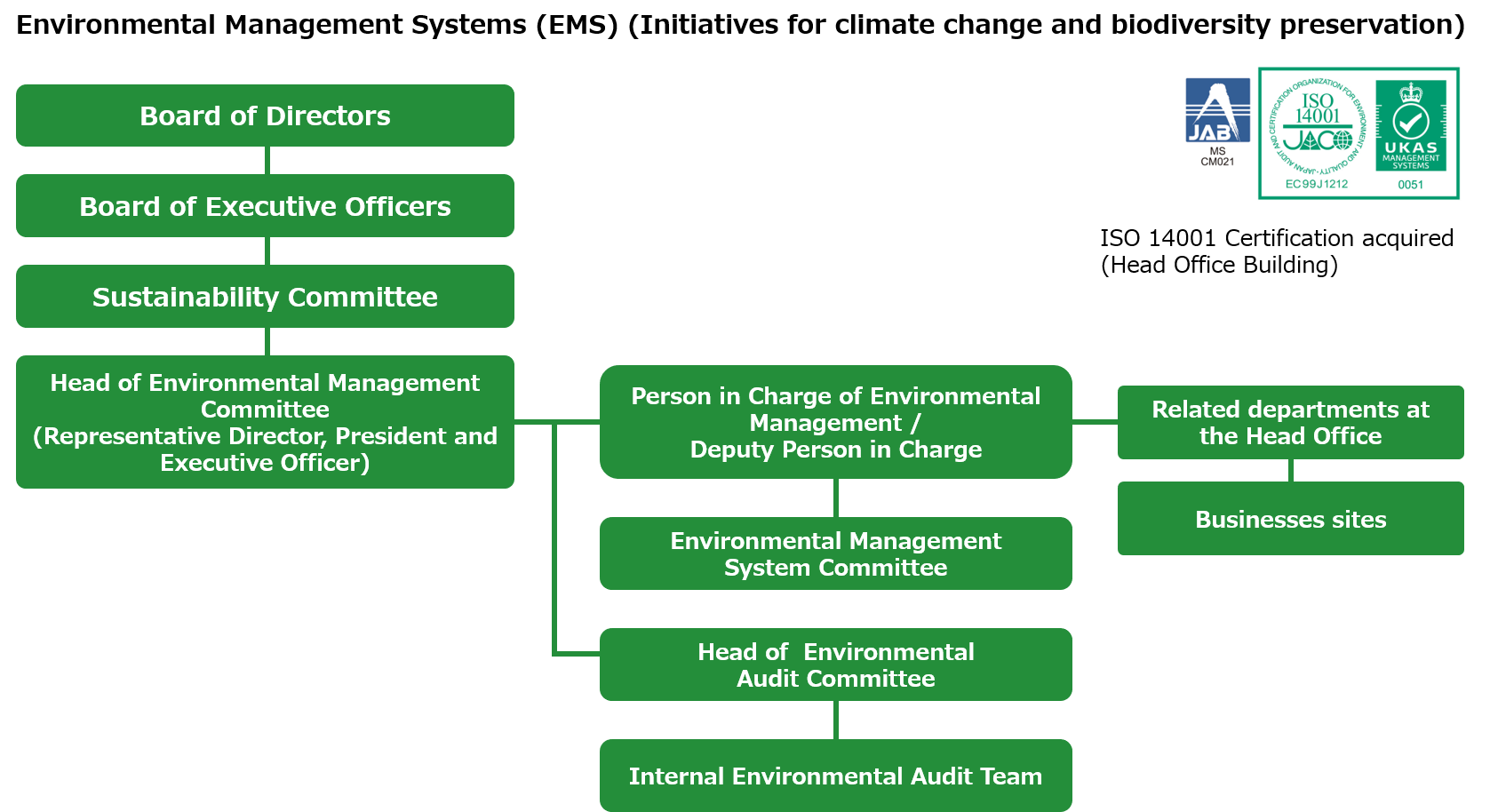
<Structure and objective of the compensation system for directors>
- Component percentage of performance-linked compensation set at 50% to clarify management responsibility
- Component percentage of stock compensation set at 30% to encourage management aimed at increasing corporate value from the shareholders’ perspective
- Component percentage of compensation based on ESG indicators set at 20% to promote sustainability-oriented management from a medium- to long-term perspective

Among the components of the compensation paid to the Group’s directors, stock compensation granted as long-term incentive compensation accounts for 30% of total compensation. Of this, 10% is granted in issued shares as environmental management indicator-linked compensation (the remaining 20% consists of 10% provided as ROE-linked compensation and 10% as employee engagement indicator-linked compensation). Transparency and objectivity of this compensation system and the amounts paid are ensured through approval by the Board of Directors following deliberation by the Nomination and Compensation Committee, which is chaired by an outside director and whose majority also consists of outside directors.
Various climate-related challenges including the establishment of nature-related targets, decision-making on carrying out capital investment and other measures to reduce GHG emissions, and the achievement of performance improvements are effectively integrated into the governance mechanism, and this is believed to be having a positive effect on the Board of Directors’ oversight of nature-related issues.
Since its foundation, the Joshin Group has valued the principle of its Corporate Credo “Thoughtfulness,” which means “to always act in consideration of the other’s perspective.” This principle is interconnected with the concept of respecting human rights, which is about honoring individual values.
As a means of clearly indicating, both internally and externally, our intention of contributing to the resolution of social issues through our business activities grounded in the spirit of respect for human rights, we signed the United Nations Global Compact in July 2022 and announced the Joshin Group Human Rights Policy in December that year.
We will endorse and participate in such initiatives and frameworks premised on respect for Indigenous Peoples, local communities, and other stakeholders and share our Policy on respecting human rights with our stakeholders including business partners. We will also strive to encourage understanding of the Policy, further promote it, and ensure its wide acceptance.
Responding to society’s various demands on the Group on environmental and human rights matters is no longer just our responsibility but that of the entire supply chain. For this reason, we established our Procurement Policy, which covers the selection of business partners based on a consideration of human rights, working conditions, and the natural environment, as well as monitoring and improvement efforts. With the Policy in place, we will work toward sustainable procurement. In addition, based on the Procurement Policy, we have formulated Procurement Guidelines aimed at encouraging the entire supply chain to work to maintain and improve the natural environment and society. The Guidelines present items that we ask all our suppliers to comply with.
Following the establishment of human rights-related policies and guidelines, in January 2024 we produced a video aimed at raising stakeholder awareness titled Joshin Group ESG—About the Joshin Group Procurement Guidelines. The video covers the Group’s efforts on such environmental, social, and governance (ESG) issues as environmental protection, respect for human rights, and anti-corruption. We sent the video’s access information to our top 249 suppliers along with a supply chain procurement questionnaire and asked them to view the video. Compared to gathering in person for an explanatory meeting, this made it possible for our suppliers to view the video more efficiently at their convenience during the viewing period.
In addition, using an online questionnaire system to take questions and provide responses ensured that our suppliers gained a better understanding of the purpose of the Group’s Procurement Policy and Procurement Guidelines, as well as the details of our ESG-related activities.
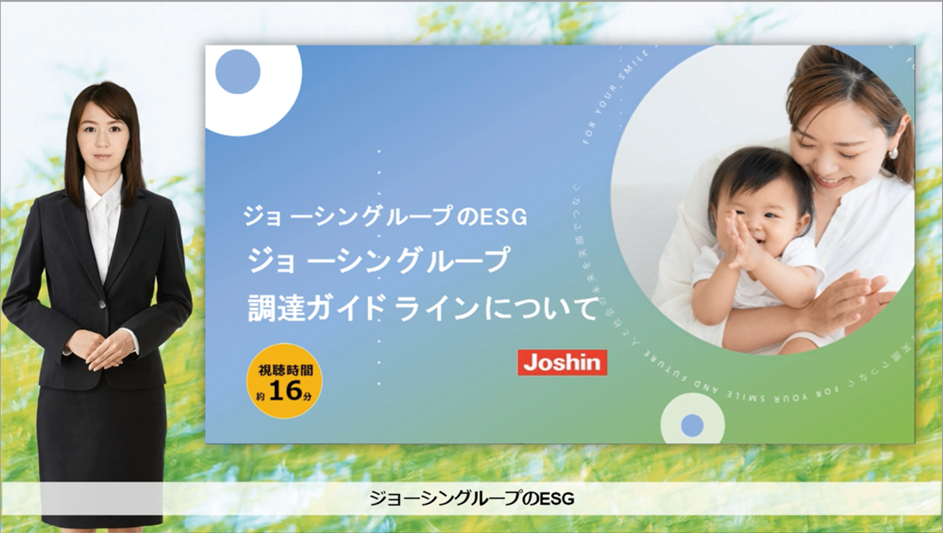
By continuing to conduct questionnaire surveys on procurement, we will identify problems that exist in our supply chain with respect to human rights, the environment, and other factors. If improvement is required, we will work together with our suppliers and engage in dialogue toward remedies. We will also actively create opportunities for dialogue with suppliers who do not submit questionnaire responses to improve their engagement.
In order to present the effects of the Group’s biodiversity-related and other environmental initiatives and their final outcome from the perspective of financial value, we have mapped out the relationships among direct value, communication, and financial value factors, which culminate in the improvement of corporate value as shown below.
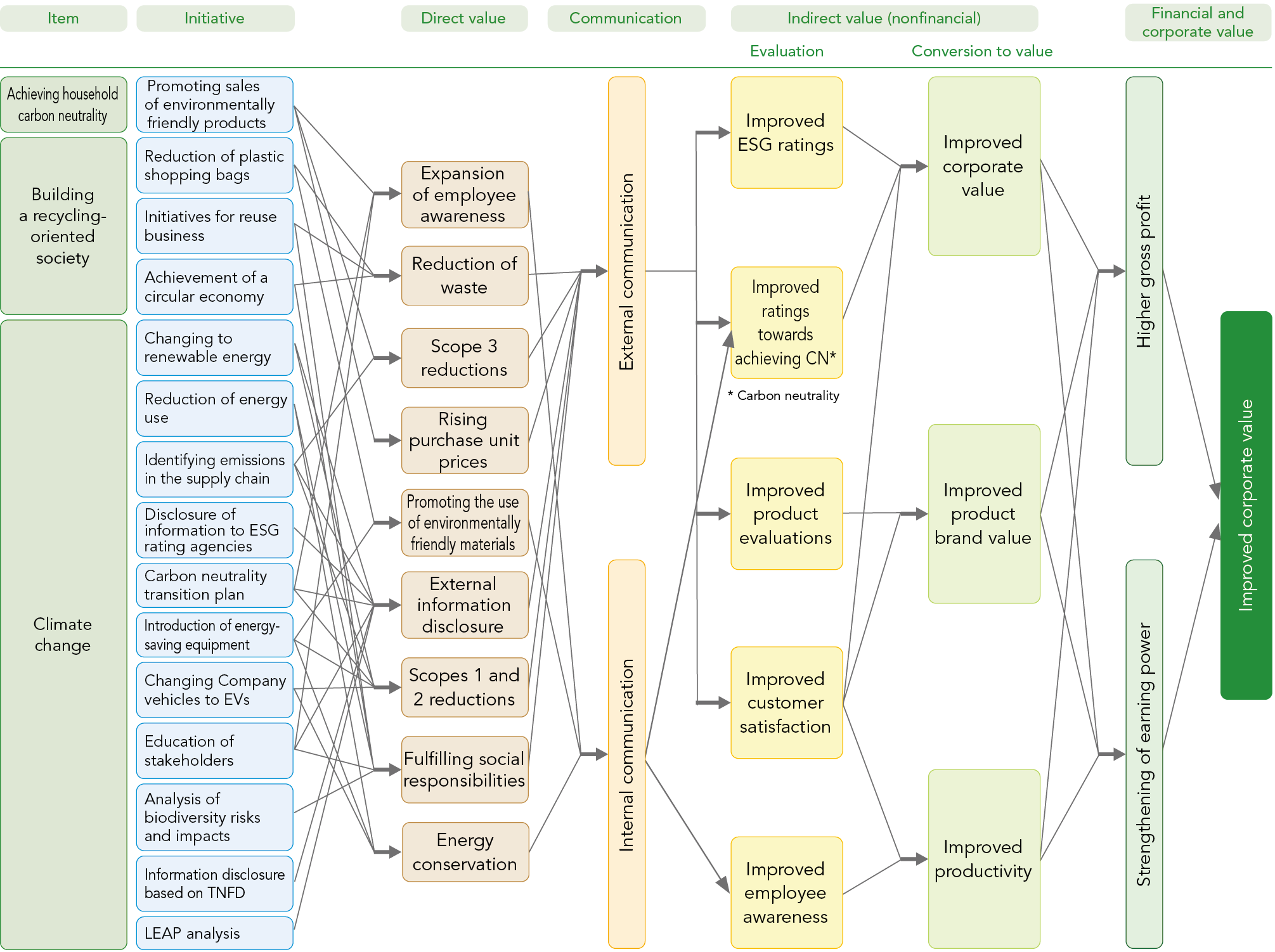
Our economic and social activities are dependent on natural capital, which provides us with nature’s bounty. In turn, individual and organizational business activities have either positive or negative impacts on the state of nature, and as a result, on the flow of ecosystem services. For the Group to assess and disclose its impact on nature and biodiversity, it is necessary to identify its interface with nature, or in other words, its dependencies and impacts on nature.
For the Group’s direct operations, we have created a Business Model Clarification Chart listing the factors involved in the home appliances sector’s value chain. This has enabled us to clearly identify the operational processes, raw materials, products, customers, and business operators involved in the upstream, midstream, and downstream segments of the Group’s business.
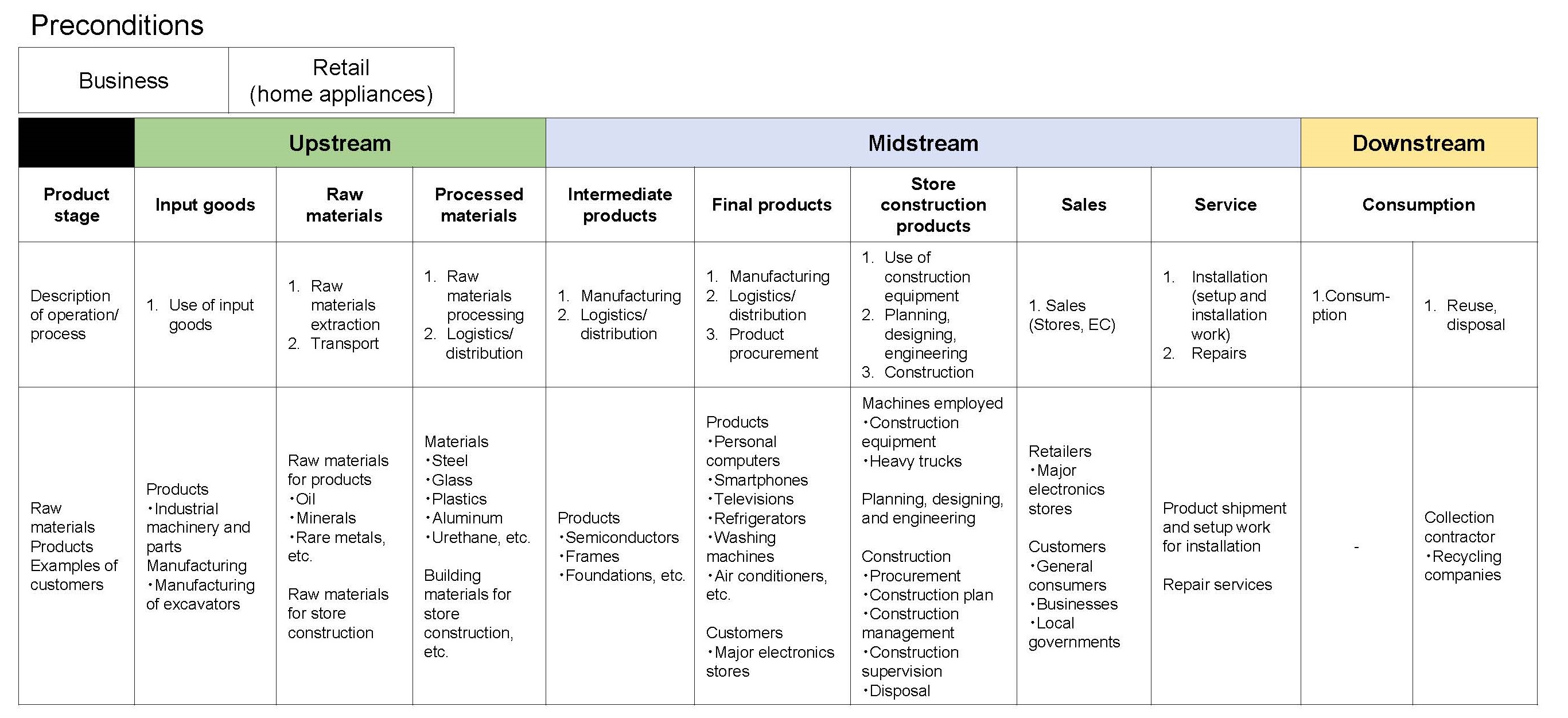
As a result of assessment using the Exploring Natural Capital Opportunities, Risks and Exposure (ENCORE) tool, none of the processes in the retail business of products including home appliances were assigned a Very High dependency materiality rating. In addition, we were able to determine the processes with Very High impact materiality ratings as well as the impact drivers of ecosystem services with Very High impact materiality ratings as shown below. The assessment also allowed us to sort out the factors involved in the value chain of the business model of our retail business of products including home appliances and to identify our material dependencies and impacts (effects).
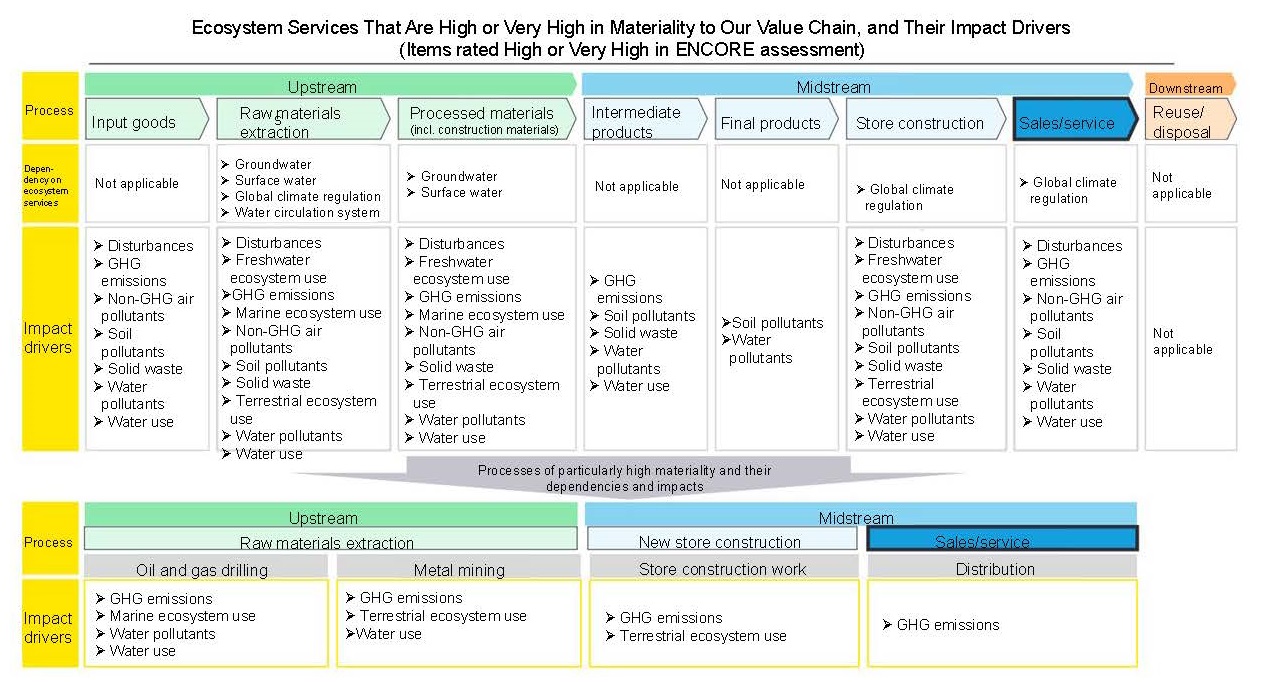
Locate, evaluate, assess, and prepare—or LEAP for short—is an approach recommended by the TNFD as a comprehensive process to assess an organization’s interface with nature, dependencies and impacts, risks and opportunities, and other nature-related issues. The Group conducted a nature-related assessment of its core retail business of products including home appliances taking into account the LEAP approach (TNFD Framework ver. 1.0)
1. In the Locate phase of LEAP, we analyzed the interface with nature of 40 sites selected from among all 261 of our sites conducting direct operations (stores, service centers, and logistics centers)
2. Using the Integrated Biodiversity Assessment Tool (IBAT) and Aqueduct, TNFD’s recommended tools, we identified each site’s interface with nature of the surrounding area as well as the water stress the sites faced.
- Using IBAT, we looked at areas within a 50 km radius of the sites and confirmed the number of species on the International Union for Conservation of Nature’s (IUCN’s) Red List of Threatened Species, the number of Protected Areas (PAs), and the number of Key Biodiversity Areas (KBAs). We used Aqueduct to confirm our comprehensive water risk.
- Looking at the interface with nature within a 50 km radius of relevant sites using IBAT, the highest number of species on the IUCN Red List were found around a site located in central Wakayama Prefecture (2387 species), the highest number of PAs were identified around a site in Kanagawa Prefecture (266 areas), and the highest number of KBAs were found around a site in Aichi Prefecture (12 areas).
- An Aqueduct analysis revealed that, with respect to the overall water risk of our business site locations, a site in Hyogo Prefecture was rated Medium-High, a site in Niigata Prefecture was rated Low, and all others were rated Low-Medium. It was found that the Hyogo site that was assigned a Medium-High rating was exposed to high water stress risk, a component of overall water risk.
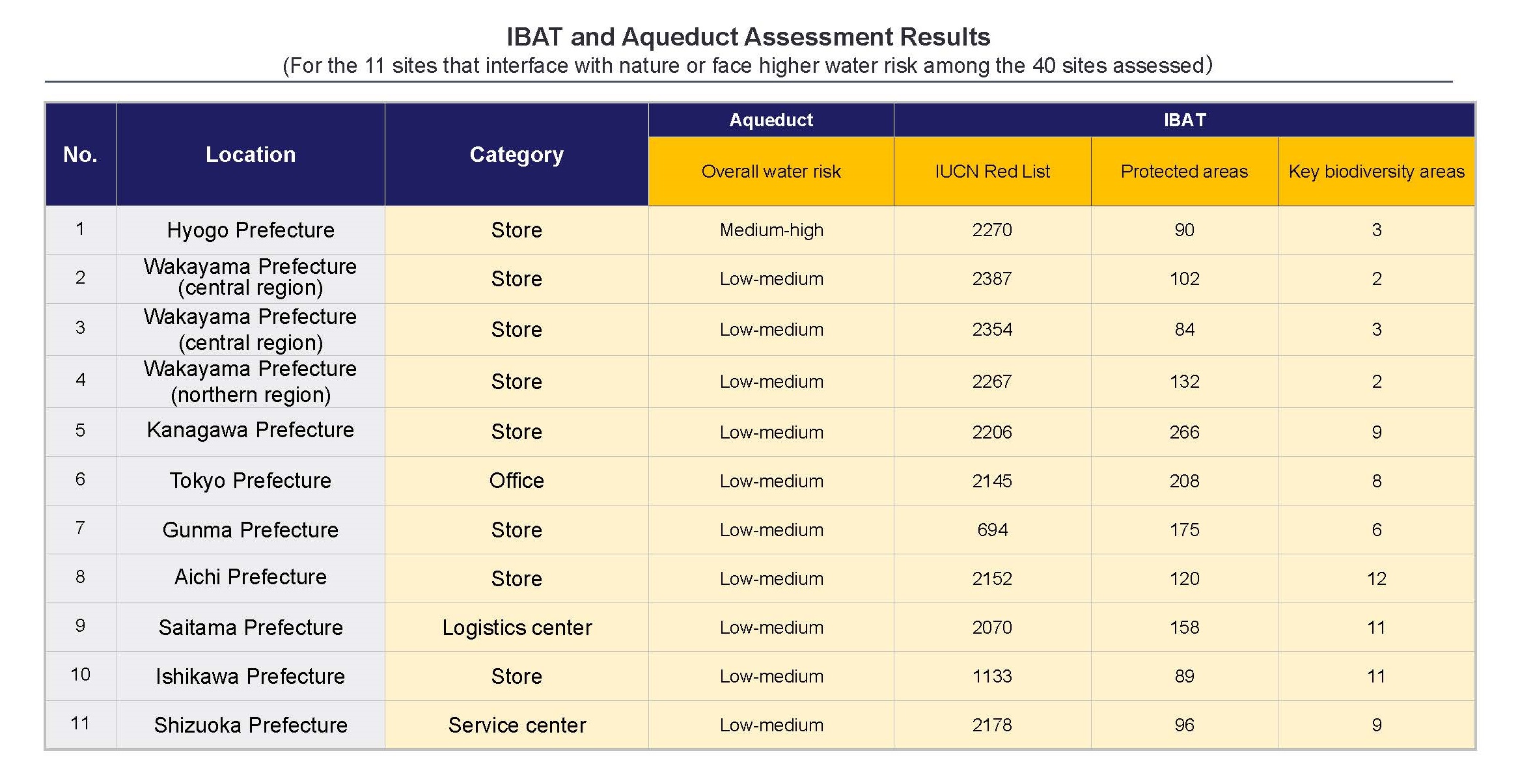
Using the results of our Business Model Clarification Chart, we analyzed and assessed our dependencies and impacts on biodiversity and natural capital at each stage from the upstream to downstream segments of our value chain employing the ENCORE tool. This allowed us to determine the key dependencies and impacts in our business model. Through a dependency and impact analysis of the direct operations of each of the Group’s stores, service centers, and logistics centers, the following were identified.
1. Dependencies (ecosystem services on which the Group is dependent):
There are dependencies including the dependency on water supply as we use water in cleaning, laundry, car washing, and in the display and actual use of certain products and on biomass provisioning due to the use of renewable energy.
2. Impacts (impact drivers):
We identified impacts including the following: land-use change through the use of land for our business sites, pollution resulting from the generation of waste, resource use through the use of energy and water, climate change due to energy use, and invasive alien species caused by their adherence to products, consumables, supplies, and other items that arrive at sites from outside the area.
Furthermore, as a result of analysis using ENCORE of the dependencies and impacts of our entire value chain linked to our retail business of products including home appliances, as well as the impact of invasive alien species caused by their adherence to supplies and other items, no processes were rated as being Very High in dependency materiality.
As for impact, the processes found to be Very High in materiality were oil and gas drilling and metal mining in the upstream segment and store construction and product distribution in the midstream segment of our value chain. The impact drivers of each of the processes rated to have Very High impact were confirmed as shown in the figure below.
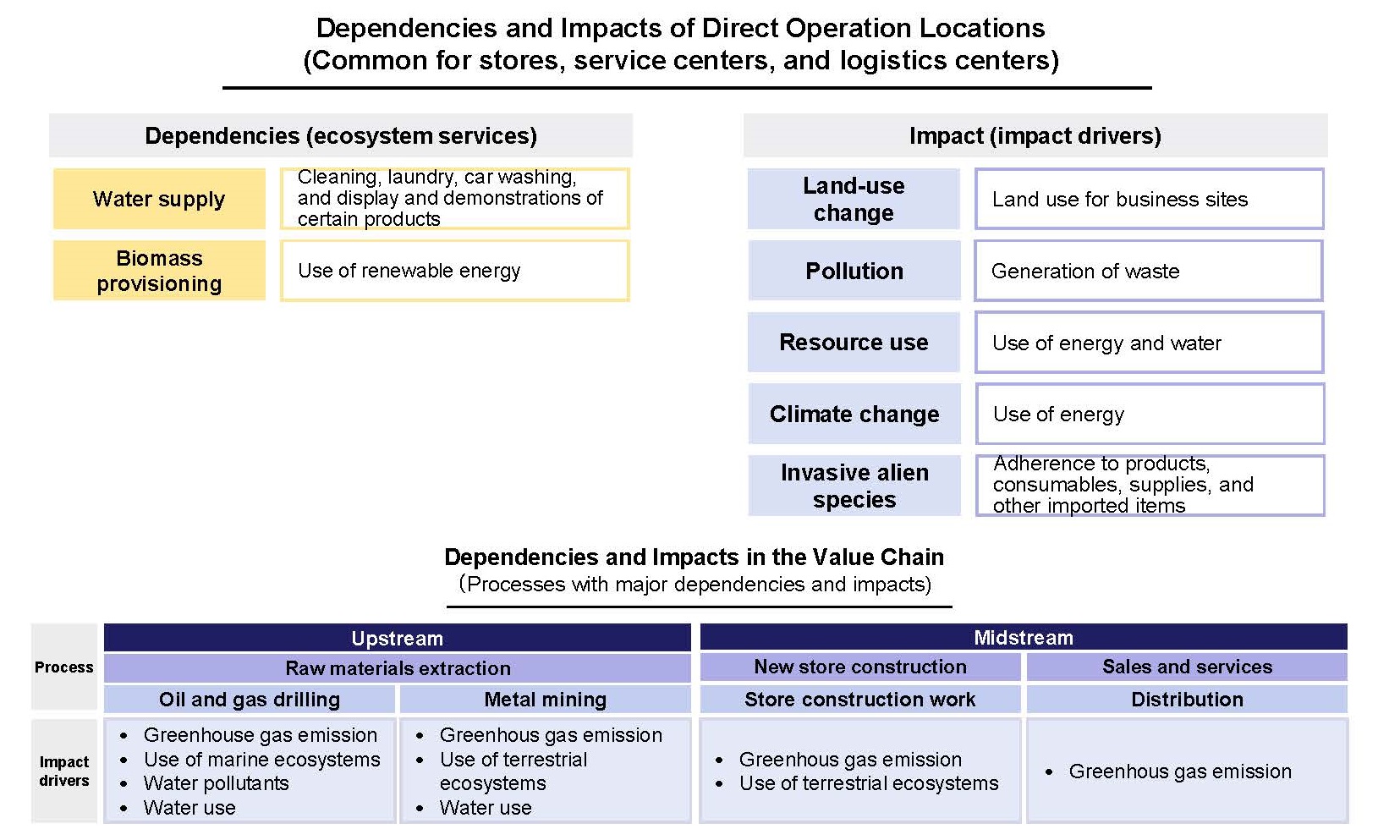
1. For the 11 sites selected from the results of the initial Locate phase, biodiversity and water-related risks of the surrounding areas were identified using the WWF Risk Filter, tools recommended by the TNFD.
2. We conducted a qualitative study of risks in light of our assessment based on the WWF Risk Filters and the dependencies and impacts identified in the Evaluate phase. The identified risks and opportunities and the actions planned as a result are shown in the chart below.
- From the results of analysis using the WWF Risk Filters, natural disaster risks such as typhoons, landslides, extreme heat, and flooding, as well as reputational risk linked to freshwater biodiversity, were identified. Of these, natural disaster risks were identified as being highly relevant to our business because natural disasters could result in damage including that to business sites.
- With respect to the impact of invasive alien species, which is one of the dependencies and impacts of direct operations identified in the Evaluate phase, there is the possibility that fire ants transported in cargo could lead to economic losses and other damage. As such, the risk of alien species attaching onto cargo and being introduced to Japan has been identified as being highly relevant to our business.
- As for the impact of the raw materials extraction process (emission of greenhouse gases, use of marine and terrestrial ecosystems, water pollutants, and water use), which is among the dependencies and impacts of our value chain identified in the Evaluate phase, there is the possibility that products whose raw materials extraction processes have a major impact on nature may become subject to regulation, resulting in product discontinuation or procurement instability, and there may be changes in demand due to consumers’ rising environmental awareness, among other risks. As such, procurement risk and inventory risk resulting from damage to nature during the raw materials extraction process were identified as risks that are highly relevant to our business.
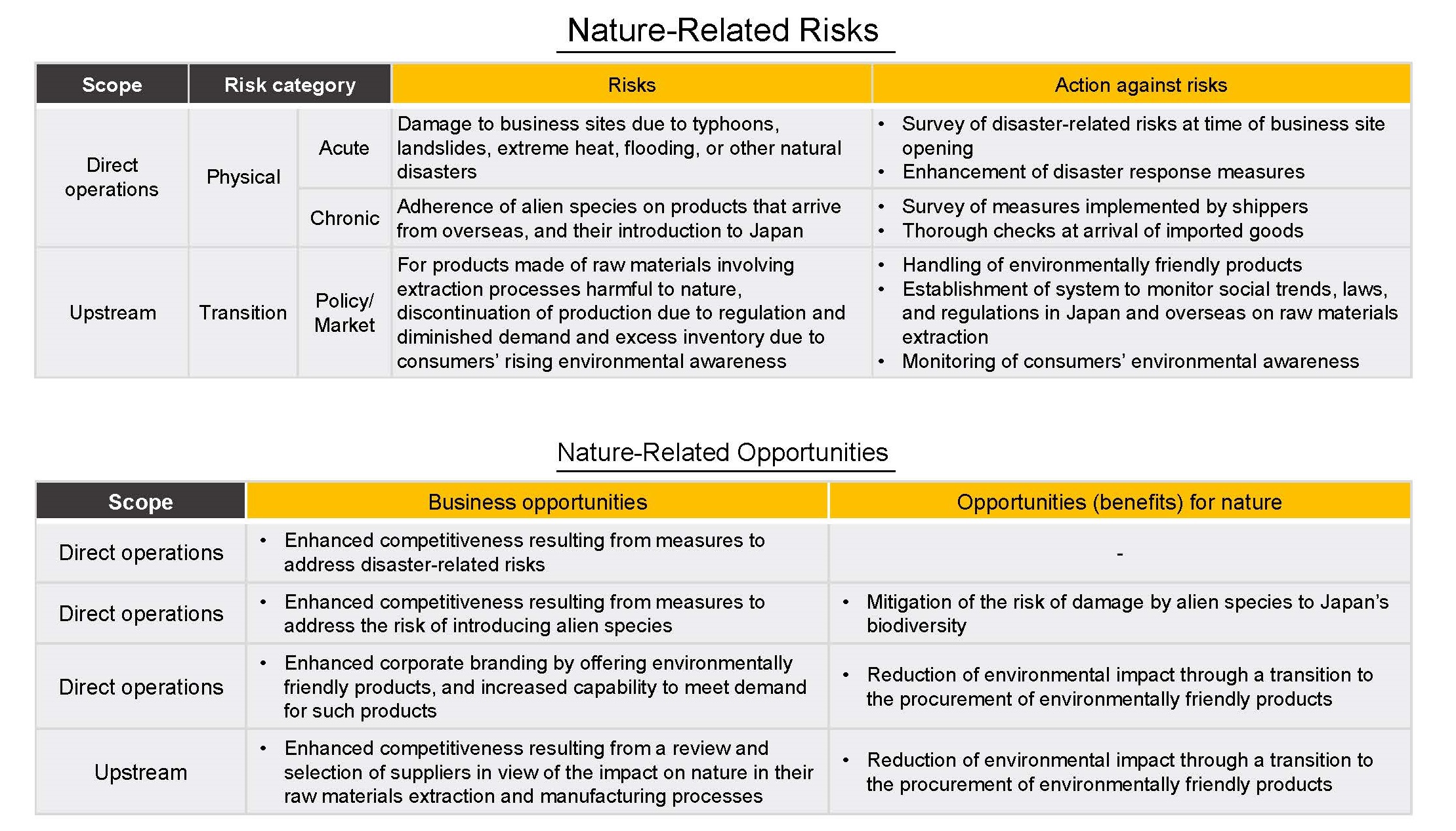
For action planned up to 2030, please refer to TNFD Analysis of Risks and Opportunities and Actions to Address Them.
Considering aspects including the risks and opportunities identified in the Assess phase, we analyzed the nature-related risks and opportunities that arise from the Group’s business activities.
The opportunities include material recycling initiatives, measures to reduce the environmental load through such efforts as waste reduction and reuse, and climate change measures such as contributing to greenhouse gas reduction through the sale of environmentally friendly products and emissions reduction through the introduction of renewable energy. Risk factors, on the other hand, include the decline in natural capital due to the use of energy resources and the impact on climate change and the environmental load due in part to our emissions into the atmosphere and water bodies, and we are aware that our activities impact biodiversity in various ways.
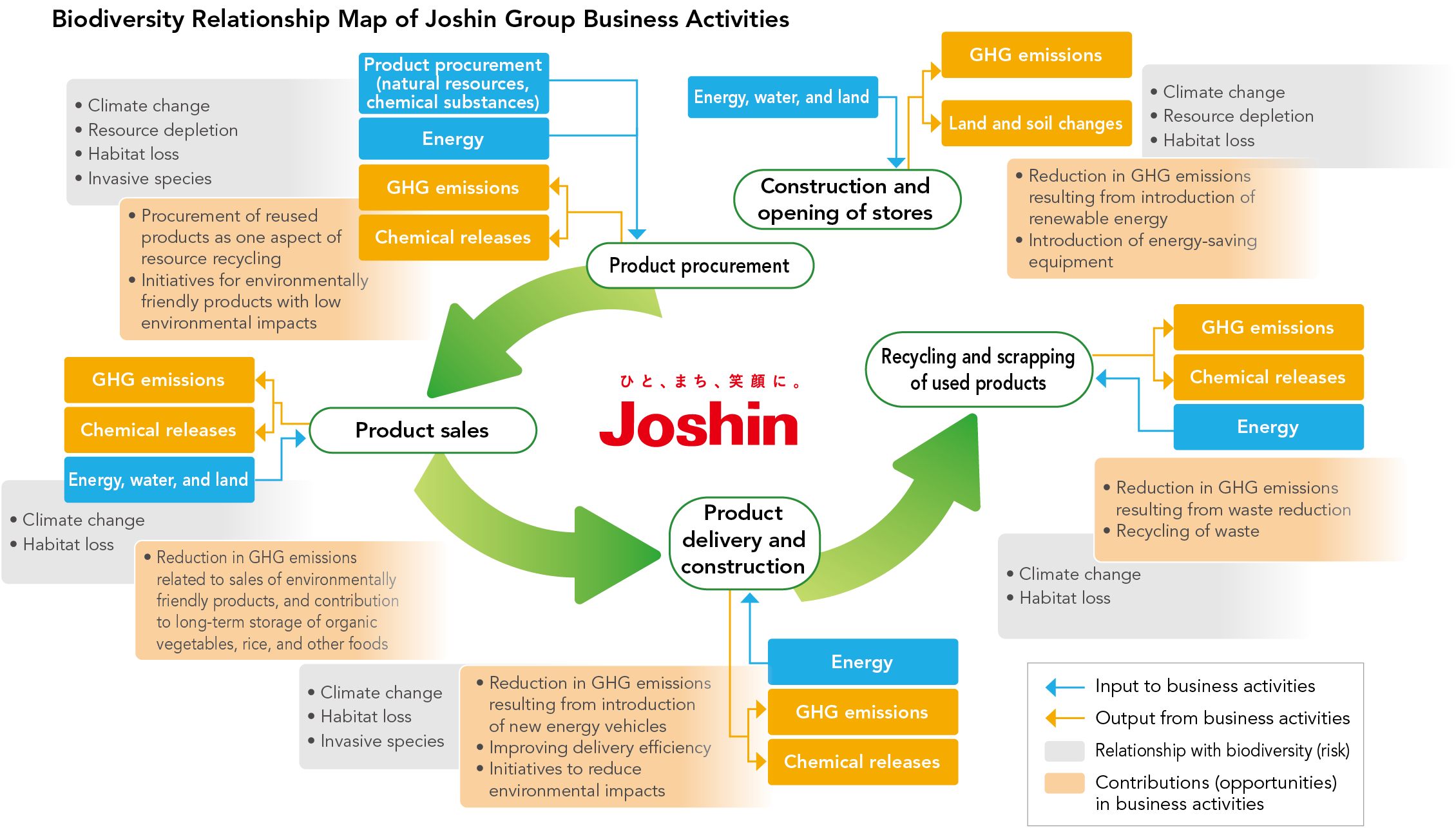
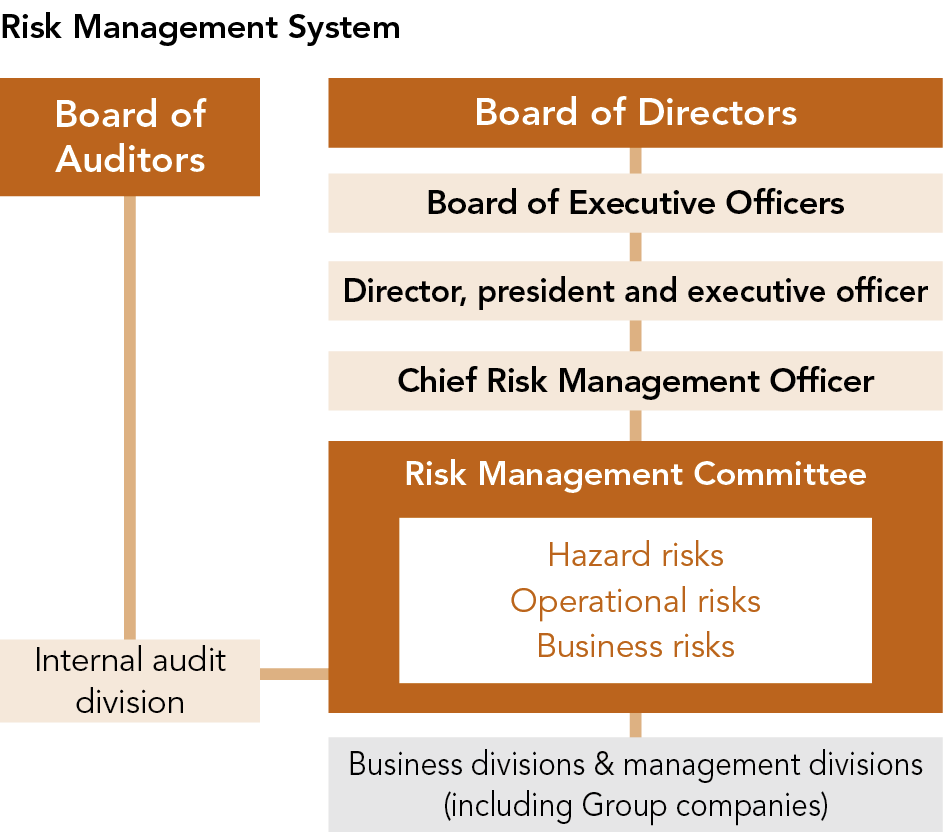
To comprehensively assess, evaluate, and manage the various risks that exist around it, the Group has established a Risk Management Committee at Joshin Denki and created an enterprise risk management (ERM) system. Once a year, the Committee identifies and assesses risks that may interfere with achievement of the targets of the JT-2025 Management Plan (medium-term management plan) and other risks that could impact the Group and confirms the status of the Group’s measures to address high-priority risks.
In the event of a material incident, the Disaster (Accident) Countermeasures Committee, chaired by the president and executive officer, is convened as an emergency organization to act on the business continuity plan and otherwise facilitate initial response measures to minimize the impact on the Group’s management. Amid the growing threat of major natural disasters as well as cybersecurity risks, we will fulfill our social responsibility to stakeholders by ensuring the early recovery and continuity of business activities.
For recognized risks, we have created a risk map with the degree of impact and probability of occurrence as the axes. Monitoring of the status of those risks, as well as the measures to address them, are being strengthened in order to avoid or mitigate the risks.
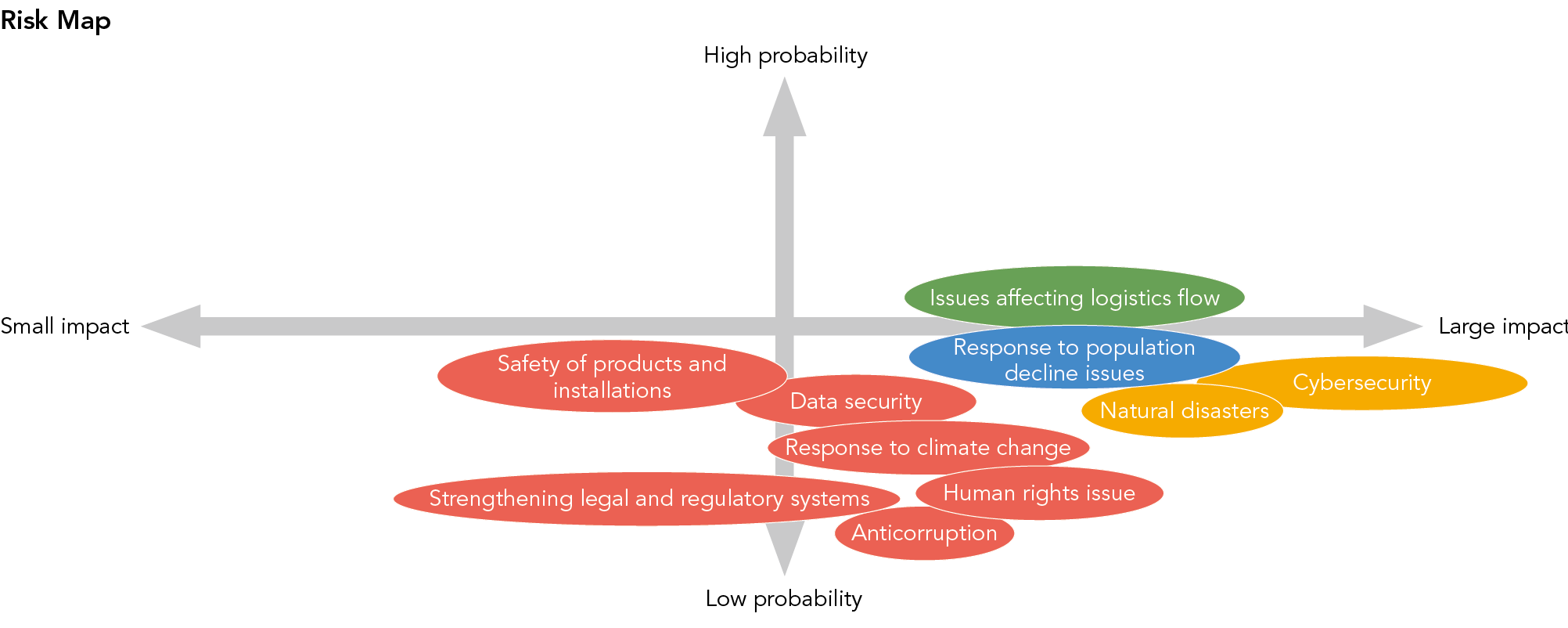
The Group has established the following metrics for nature-related dependencies and impacts, as well as risks and opportunities. For details on actions planned up to 2030 related to these metrics, please refer to the chart Analysis of Risks and Opportunities and Actions to Address Them.
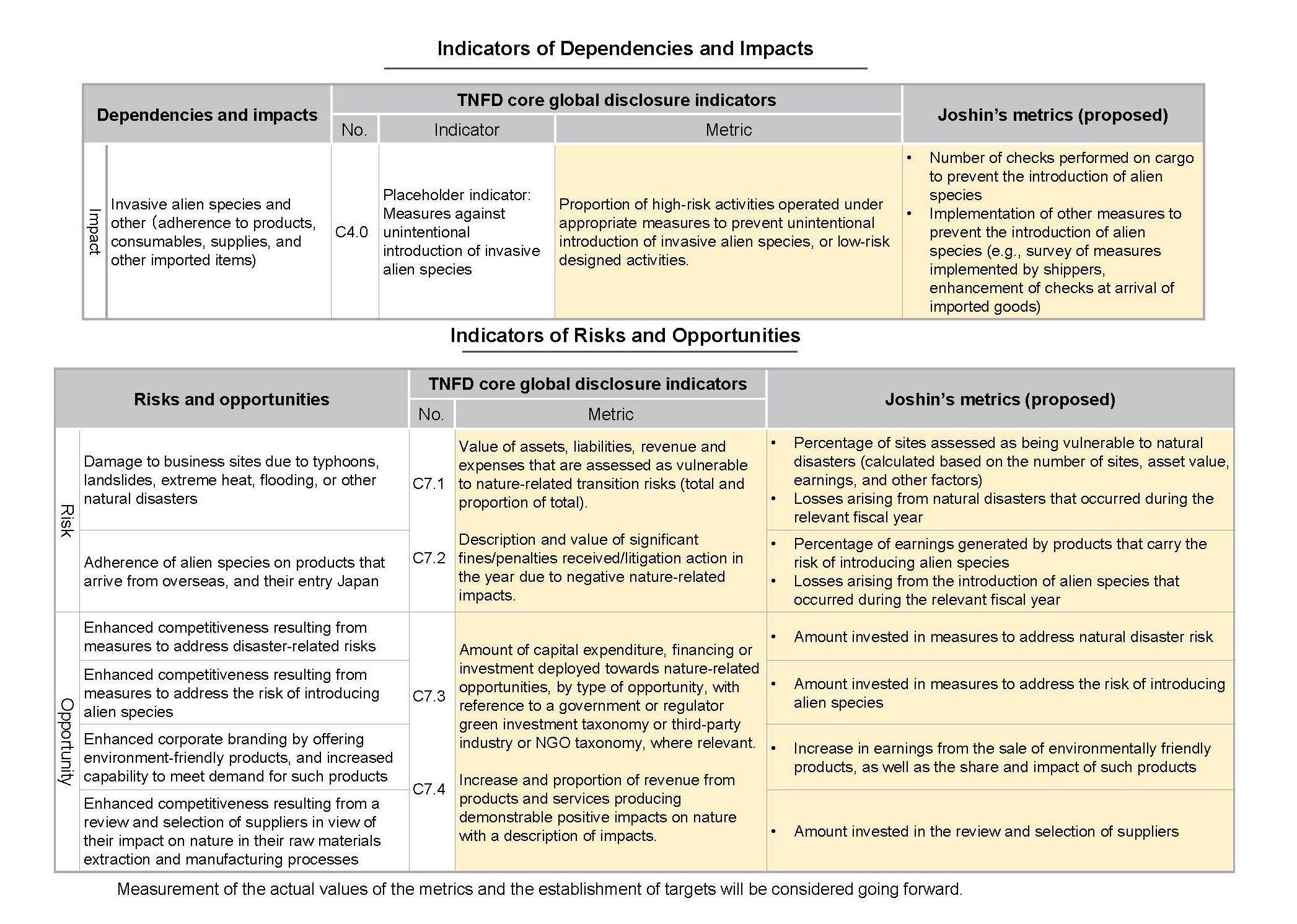
.jpg)
